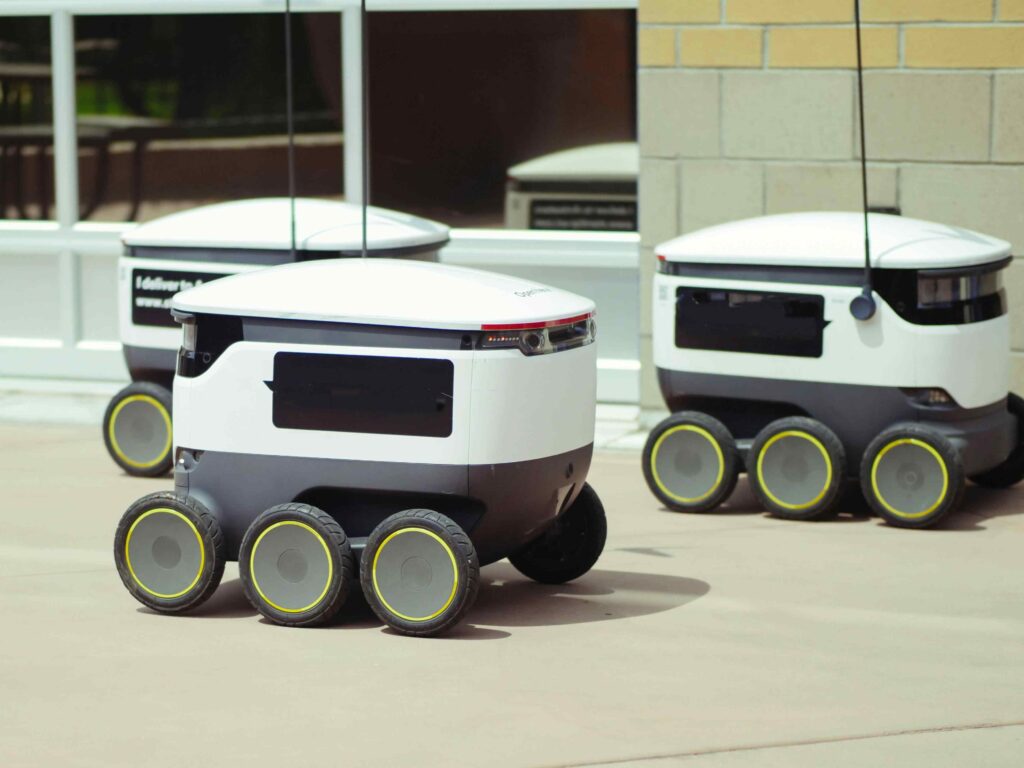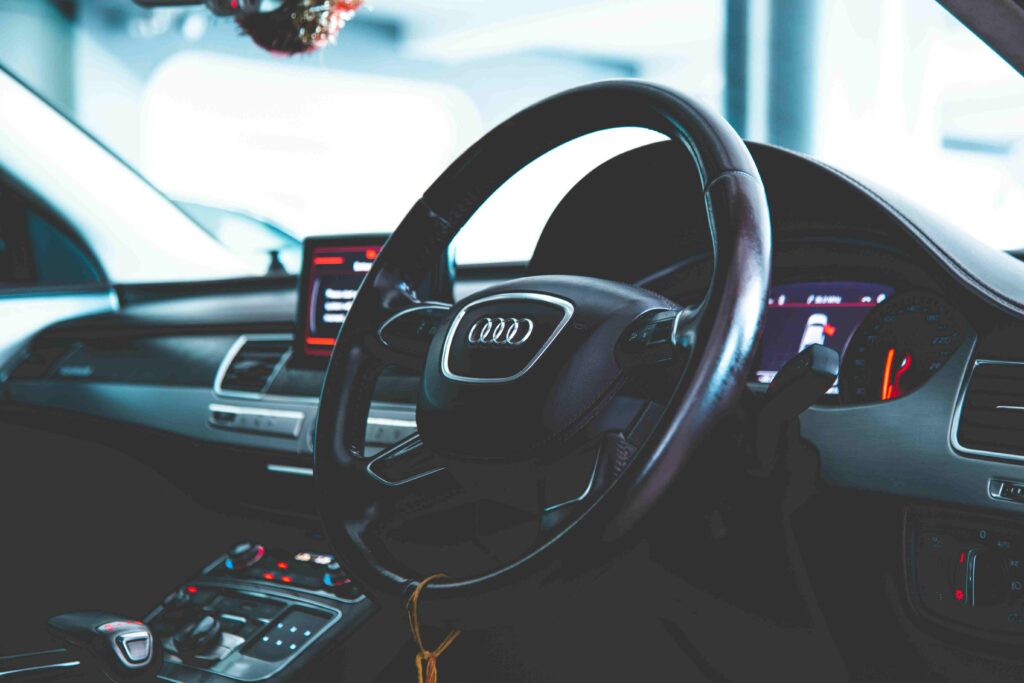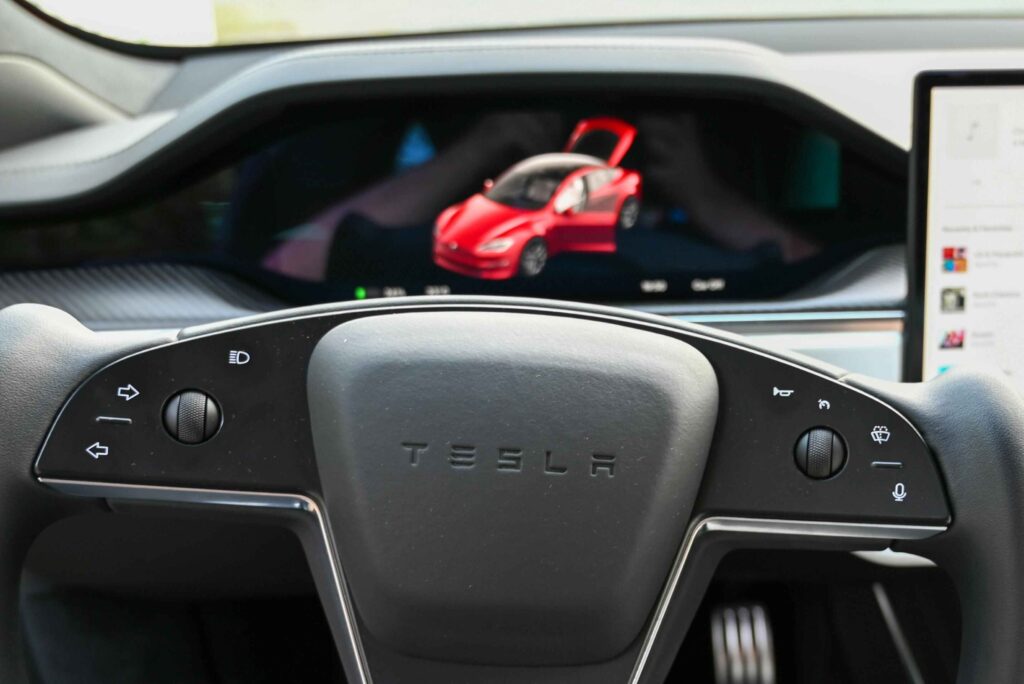Introduction
Autonomous vehicles (AVs) are among the most hyped applications of artificial intelligence today. When people hear “autonomous vehicles,” they often imagine fully self-driving cars navigating city streets. But in reality, AI’s role in this space is far broader — from smart infrastructure and connected ecosystems, to delivery robots, simulation, regulatory oversight, and in‑vehicle intelligence for safety, comfort, and energy efficiency.
If you’re exploring careers in AI for autonomous vehicles beyond just self‑driving cars, you’re entering a frontier full of opportunity, complexity, and impact. In this extended guide, I’ll walk you through:
Table of Contents
Why “Beyond Self‑Driving Cars” Matters
To truly appreciate the breadth of opportunity, let’s contrast “self‑driving car AI” with the broader autonomous mobility ecosystem.
Limitations of thinking only in “self‑driving car” terms
- Narrow tech focus: Many imagine only perception, planning, control modules. But an AV ecosystem spans infrastructure, networks, simulation, fleet management, and more.
- Single domain risk: If you focus only on driving stack, you may miss adjacent fields that may grow faster or be less saturated.
- Regulatory & ethics gap: Many career needs are in ethics, policy, assurance, compliance — not just coding.
- End‑user experience & operation: For autonomous mobility to be accepted, roles in UX, human interaction, maintenance, and operations are vital.
The broader ecosystem
The autonomous mobility ecosystem includes:
- Road and traffic infrastructure (smart traffic lights, sensors embedded in roads, vehicle‑to‑infrastructure communication)
- Last‑mile delivery robots (ground bots, drones)
- Fleet operation & logistics
- Safety, validation, simulation, testing
- In‑vehicle intelligence beyond motion (comfort, health monitoring, natural language interfaces)
- Mapping, localization, geospatial analytics
- Ethical / regulatory policy & standards
- Energy, power, sustainability systems
So when you aim to build a career in AI in this ecosystem, you have many more levers to pull.

Emerging Applications & Use Cases
Here are concrete use cases and application areas beyond just “self‑driving cars” that are accelerating, and all require AI.
| Application | Description | AI’s Role / Challenges | Example Companies / Projects |
|---|---|---|---|
| Autonomous Last‑mile Delivery Robots / Drones | Small ground robots or aerial drones delivering food, parcels, medicines in neighborhoods | Path planning, obstacle avoidance, perception in cluttered environments, navigation in unstructured spaces, energy constraints | Nuro (robots), Amazon Scout, Wing (Google/Alphabet), Starship Robotics |
| Vehicle‑to‑Everything (V2X) & Smart Infrastructure | Roads, traffic signals, street sensors communicate with vehicles; dynamic signaling, predictive routing | Real‑time data fusion, networked AI, latency management, distributed decision making | Smart cities, municipal traffic control systems, telecom + infrastructure firms |
| High‑Definition (HD) Maps & Real‑Time Mapping | Maintaining maps with fine detail (lanes, signs, curbs) and updating them in real time | Geospatial AI, point cloud / LiDAR processing, map update detection, map compression | HERE, TomTom, Mapbox, Waymo’s map teams |
| Simulation & Digital Twins | Virtual environments, fault injection, scenario generation, synthetic data for training & test | Domain randomization, scenario diversity, safety validation, synthetic sensor modelling | Companies offering simulation tools (e.g. CARLA, LGSVL, NVIDIA) and internal simulation teams |
| In‑Vehicle AI / Driver / Passenger Intelligence | Cabin monitoring, emotion detection, voice assistants, personalized settings (seat, climate, media), health sensors | Computer vision, NLP, multimodal sensor fusion, real-time inference | Automotive OEM tech arms, infotainment system providers |
| Fleet Operations, Logistics, & Optimization | Managing fleets, routing, predictive maintenance, utilization, cost control | Operations research, predictive modeling, scheduling, optimization | Delivery companies, ride‑hail platforms, mobility service providers |
| Safety, Assurance, & Validation | Ensuring autonomous systems are safe, robust, compliant, and trustworthy | Formal methods, uncertainty quantification, validation pipelines, test generation | OEM safety divisions, regulatory bodies, testing labs |
| Energy & Sustainability | Optimizing energy use, eco-routing, battery / hybrid power management, vehicle energy scheduling | Optimization algorithms, predictive energy models, reinforcement learning | EV manufacturers, green mobility startups, research groups |
| Ethics, Policy & Standards | Handling liability, governance, fairness, regulation, data privacy, public acceptance | Policy modelling, human factors, risk assessment, AI ethics frameworks | Governments, regulatory agencies, automotive consortia, think tanks |
These use cases show how AI in autonomous mobility touches many domains beyond just the “driving brain.”
Deep Dive: Key AI / Technical Domains & Their Interplay
Each of the application areas above typically maps to one or more technical / AI subdomains. To build a career, you’ll often specialize in one but must understand the system interplay.
Perception & Sensor Fusion
What it is: Converting raw sensor data (camera, LiDAR, radar, ultrasonics) into meaningful representations: object detection, classification, tracking, segmentation, semantic understanding.
Challenges:
- Multi-modal fusion (how to combine LiDAR, camera, radar)
- Sensor calibration, alignment, synchronization
- Real-time performance under strict latency & compute constraints
- Edge robustness (weather, lighting, occlusion)
- Domain shift (deploying models in new cities)
Skills / tools: Deep learning (CNNs, segmentation models, point cloud networks), ROS, Open3D, sensor calibration frameworks, C++/CUDA, GPU/accelerator optimizations, SLAM / simultaneous localization and mapping.
Many survey papers cover the deep learning aspects of perception in autonomous driving. arXiv
Mapping, Localization & Geospatial Intelligence
What it is: Precisely locating the vehicle relative to the map, updating maps, handling dynamic changes.
Challenges:
- Precise localization errors on the order of cm
- Map maintenance & updates (road changes, construction)
- Aligning sensor observations to map • Handling loop closure, drift
- Large-scale geospatial data processing and compression
Skills / tools: Point cloud alignment, SLAM, ICP (Iterative Closest Point), map representation, GIS tools, spatial databases, satellite / aerial imagery, map update detection.
Planning, Behavior & Decision Making
What it is: Given perception & localization, deciding how to act — what path, trajectory, when to overtake, how to interact with other vehicles or objects.
Challenges:
- Multi-agent behavior modeling (other vehicles, pedestrians)
- Uncertainty and prediction (what will others do?)
- Safety constraints and fallback strategies
- Computational limits, especially in real-time
Skills / tools: Motion planning algorithms (A*, RRT, MPC), behavior planners, decision trees, game theory, reinforcement learning, probabilistic models, POMDPs, control theory.
Control & Motion Execution
What it is: Translating the planned trajectory into low-level control signals (steering, throttle, braking).
Challenges:
- Vehicle dynamics modeling, accurate control under uncertainties
- Real-time, stable control under actuation limits
- Smoothness, safety, passenger comfort
Skills / tools: Control theory, model predictive control (MPC), PID controllers, robust control, digital control, embedded systems, real-time systems.
Simulation, Testing & Virtualization
What it is: Building virtual worlds to test, validate, and stress autonomous systems with broad scenario coverage.
Challenges:
- Scenario generation (edge cases, rare events)
- Bridging the “simulation‑reality gap” (domain adaptation)
- Realistic sensor modeling (noise, artifacts)
- Scalability of simulation (many episodes)
Skills / tools: Game engines (Unreal, Unity), synthetic sensor simulation, domain randomization, automated test generation, virtual twins, software pipelines.
Edge / Embedded AI & System Infrastructure
What it is: Deploying AI models on embedded / edge devices (in the vehicle), managing system pipelines, model compression.
Challenges:
- Limited compute, energy, memory
- Latency and real-time constraints
- Model quantization, pruning, acceleration
- Reliability, redundancy, hardware-software co-design
Skills / tools: Embedded systems (RTOS, firmware), FPGA / GPU / ASIC acceleration, C++ optimization, TensorRT / ONNX, hardware-aware training.
Safety, Assurance, Uncertainty & Formal Methods
What it is: Proving or ensuring that systems behave safely under many circumstances, managing corner cases.
Challenges:
- Worst-case scenario reasoning, formal verification
- Uncertainty estimation, out-of-distribution detection
- Runtime monitoring, fallback controllers
- Standards compliance (ISO 26262, functional safety)
Skills / tools: Formal methods, safety engineering, probabilistic modeling, runtime verification, reliability engineering, safety assurance frameworks.

Data Infrastructure, Big Data & Analytics
What it is: Supporting pipelines that ingest, label, clean, store, and analyze the massive volumes of sensor + map + fleet data.
Challenges:
- Scalability, distributed systems
- Data labeling (semi-supervised, active learning)
- Dataset versioning, data quality, pipelines
- Analytics for improvement and feedback loops
Skills / tools: Big data tools (Spark, Hadoop), data engineering (ETL pipelines), data versioning (DVC), cloud infrastructure, database systems, metrics analysis.
Human-AI Interaction, UX & In-Vehicle Intelligence
What it is: How humans (drivers, passengers, pedestrians) interact with autonomous systems. May include voice assistants, awareness, sensors monitoring passengers, display & feedback systems.
Challenges:
- Understanding human intent, responsiveness
- Building intuitive UI/UX for autonomy
- Trust, transparency, explainability
- Multi-modal interaction (voice, gesture, displays)
Skills / tools: NLP, speech recognition, computer vision, UX / interaction design, human factors, explainable AI.
Energy, Optimization & Sustainable Mobility
What it is: Optimizing energy usage, eco-routing, scheduling EV charging, battery management in autonomous fleets.
Challenges:
- Predicting energy use under dynamic driving
- Balancing route efficiency vs energy constraints
- Scheduling charging & route planning in fleets
- Integrating renewable energy & grid dynamics
Skills / tools: Optimization, reinforcement learning, predictive modeling, power systems modeling, scheduling algorithms.
Ethics, Policy, Regulation & Governance
What it is: Ensuring autonomous mobility is ethically grounded, safe, legal, and socially beneficial.
Challenges:
- Liability and liability frameworks
- Handling edge case moral decisions
- International / regional regulatory differences
- Data privacy, transparency, accountability
Skills / tools: Policy analysis, AI ethics, human factors, law / governance, standards bodies involvement.
Frontier AI & Large Language Models in Transportation
As recent research shows, the frontier of AI (foundation models, large language models) is being tapped for transportation systems. For instance, integrating LLMs to understand traffic, natural language interaction, reasoning about dynamic context, and smart city integration. arXiv
In future, your career might involve adapting a foundation model to operate as a mobility “assistant” inside vehicles or across infrastructure.
Specific Roles & Career Paths (Beyond Driving Stack)
Now we map roles to the subdomains above, showing responsibilities, skill requirements, growth path, and sample job titles.
| Role / Title | Subdomain(s) | Key Responsibilities | Skills / Tools | Career Path & Growth Notes |
|---|---|---|---|---|
| Perception / Sensor Fusion Engineer | Perception, sensor fusion | Develop object detection, segmentation, sensor calibration, multi-modal fusion | Deep learning (CNN, point cloud networks), ROS, C++/CUDA, sensor calibration | Start as junior vs dataset → senior → lead perception head |
| Mapping & Localization Engineer | Mapping, geospatial | Build and update HD maps, align sensor data, detect map changes, localization algorithms | SLAM, point cloud processing, GIS, map compression | Move into map architecture, map platform leadership |
| Planning & Behavior Engineer | Planning, decision making | Behavior modeling, motion planning, trajectory generation, interacting with other agents | MPC, RRT, reinforcement learning, decision theory | Senior planner, behavior lead, algorithm architect |
| Control / Motion Engineer | Control | Translate trajectory into control commands, work with dynamics, real-time control | Control theory, embedded systems, PID/MPC, system modeling | Senior control engineer, system architect |
| Simulation / Synthetic Data Specialist | Simulation & virtual testing | Build virtual worlds, scenario generation, synthetic sensor data, scenario coverage | Game engines (Unreal, Unity), synthetic data, scenario scripting | Lead simulation teams, simulation platform architect |
| Embedded / Edge AI Engineer | Edge AI, systems | Optimize AI models for real-time inference on vehicle hardware | Embedded C/C++, model quantization, hardware acceleration, runtime optimization | Platform lead, hardware-software integration lead |
| Safety, Assurance & Verification Engineer | Formal safety, uncertainty | Build verification frameworks, runtime monitors, fault detection | Formal methods, probabilistic modeling, safety standards (ISO 26262) | Safety lead, assurance director |
| Data Infrastructure / Pipeline Engineer | Data infrastructure | Build data ingestion / labeling / versioning / analysis pipelines | Spark, ETL, database systems, cloud infra | Data platform lead, VP data engineering |
| Fleet Operations & Optimization Manager / Engineer | Operations, logistics, optimization | Manage fleet scheduling, route planning, utilization, predictive maintenance | OR, optimization, ML, operations research | Head of operations, logistics lead |
| In‑Vehicle AI / UX / Voice Engineer | Human-AI interaction | Build voice assistants, monitor driver/passenger, design feedback systems | NLP, speech, vision, UI/UX, human factors | UX lead for in-vehicle systems, AI assistant architect |
| Energy / Efficiency / Sustainability Engineer | Energy optimization | Eco-routing, battery management, scheduling for EV fleets | Optimization, modeling, RL, power systems knowledge | Energy systems lead, sustainability strategist |
| Ethics, Policy & Compliance Specialist | Policy, governance, ethics | Frameworks, regulations, liability, transparency | AI ethics, public policy, regulation, human factors | Policy advisor, standards committee member |
| AI / Mobility Product Manager | Cross-domain | Bridge business, tech, user requirements, roadmap for autonomous mobility products | Domain knowledge, stakeholder management, metrics | Senior product leadership roles |
| Research Scientist (Autonomous Mobility) | All subdomains, but especially frontier | Publish new methods, explore new architectures, mentor, push boundaries | Strong math, research, publications, prototype systems | Lead researcher roles, academia-industry bridges |
Above roles often overlap and collaborate — many organizations have cross-functional teams combining perception, planning, safety, simulation, etc.
Example Job Description: Autonomous Vehicle Test / Validation Engineer
Here’s a sample of what a test/validation engineer role might look like:
“Develop and execute test procedures and test plans to validate performance of vehicle systems; troubleshoot hardware‑software integration; maintain automated test pipelines; write modules for hardware-in-the-loop (HiL) / vehicle-in-the-loop (ViL) test benches.” AI Jobs
This is a role often overlooked but critical: validating that systems behave as expected under all conditions.
Real-World Companies & Opportunities
Some firms already hiring across broader autonomous mobility include:
- AiDrivers: hiring roles in drive control, robotics platforms, project leads.
- Automotive & tech giants: Tesla, Waymo, Cruise, Zoox, etc.
- Mapping / simulation firms: TomTom, HERE, simulation engine developers
- Logistics / delivery firms: startups with autonomous delivery robots
- City / infrastructure bodies: working on smart traffic, V2X deployments
Also, agriculture, mining, warehousing, and other industries are adopting autonomous systems — so your AI expertise in mobility can transfer.
What Employers Look For: Skills, Competencies & Soft Skills
To land and succeed in these roles, you need both deep technical skills and cross-domain fluency. Below is a detailed breakdown.
Core Technical Skills
| Skill / Competency | Why It Matters in Autonomous Mobility | What to Build / Practice |
|---|---|---|
| Programming & software engineering | You’ll write production-level code, integrate modules, debug across stacks | Be fluent in Python, C++, and optionally Rust; learn software design, testing, version control, CI/CD |
| Mathematics, stats & algorithms | Many AI modules rely on math — perception, planning, control, optimization | Focus on linear algebra, probability, optimization, estimation theory, control theory |
| Machine learning / deep learning | Core to perception, prediction, decision making | Practice neural networks, transformers, reinforcement learning, model training pipelines |
| Computer vision & perception | Much of environmental awareness comes from vision / sensor fusion | Work on segmentation, detection, point cloud networks, SLAM, sensor calibration |
| Embedded systems & edge compute | Critical when deploying models on vehicle hardware | Learn firmware, RTOS, hardware-software integration, optimization, quantization |
| Simulation & synthetic data | You’ll often validate in virtual worlds before real world | Learn to use Unreal or Unity, build sensor models, scenario generation, domain adaptation |
| Safety, formal methods & uncertainty | High stakes demand robustness, fail-safes, safe behavior | Study formal methods, runtime verification, uncertainty estimation, fault tolerance |
| Data pipelines & infrastructure | Autonomous systems produce huge data; engineers must build pipelines | Learn data engineering, distributed systems, cloud infrastructure, ETL |
| Optimization, scheduling & logistics | For route planning, energy scheduling, fleet planning | Study operations research, combinatorial optimization, reinforcement learning |
| Human-AI interaction & UX | For passenger experience, trust, voice / display systems | Study NLP, speech, human factors, interaction design, explainable AI |
| Domain knowledge (automotive, sensors, control) | Knowing how vehicles, sensors, dynamics work is crucial | Read about vehicle dynamics, sensors, actuation, electrical systems |
Soft Skills & Cross-Functional Capabilities
- Systems thinking: Autonomous mobility is a “system of systems” — you must see the interactions, trade-offs, bottlenecks.
- Interdisciplinary collaboration: You’ll work with mechanical engineers, electrical engineers, policy experts, user designers, safety engineers.
- Communication & documentation: Writing specs, documenting modules, explaining technical decisions to non-specialists.
- Problem decomposition & debugging: When full systems fail, you need to trace root causes across perception → planning → control → actuation.
- Ethical judgment & responsibility: Designing systems that affect safety demands moral clarity and awareness of social impact.
- Learning mindset & adaptability: The field evolves fast; staying updated is essential.
- Leadership & mentorship: As you grow, ability to lead technical teams, mentor juniors, guide architecture decisions is vital.

What employers check / expect
- Strong portfolio or projects (especially in perception, planning, simulation)
- Contributions to open source, publications, Kaggle or contest results
- Real-world or prototyping experience (robotics projects, sensor kits)
- Internship or industry experience (even small scale)
- Demonstrated mastery over both depth and breadth (you may specialize, but must know interconnections)
- Awareness of standards, safety, etc.
A Reddit commenter described how AV work often demands “real systems thinking, how to build interfaces and integrate things, understanding debugging … AV systems are complex systems of systems”
Another emphasized that sensor processing and hardware-software integration are particularly valuable skills (beyond just ML).
Educational Pathways, Certifications & Learning Strategy
To build toward these roles, here’s how you can structure your learning and credentials.
Formal Education: Degrees & Tracks
| Level | Typical Majors / Programs | Benefits | Considerations / Tips |
|---|---|---|---|
| Undergraduate (Bachelor’s) | Computer Science, Electrical / Electronics, Mechanical, Mechatronics, Robotics, Aerospace | Build core programming, math, systems understanding, hardware basics | Seek robotics / autonomy electives, sensor labs, team projects |
| Master’s / MTech / MS | Specialize in AI, Robotics, Autonomous Systems, Embedded Systems | Depth in specialization, research opportunities, thesis work | Select research groups active in autonomy / mobility |
| PhD / Doctorate | Advanced research in AI, perception, planning, etc. | Publishable work, leadership in research & innovation | Requires motivation; often suited if aiming for high cutting-edge roles |
Online Courses, Bootcamps & MOOCs
You can accelerate or supplement degrees with targeted online learning:
- Autonomy / self-driving car nanodegrees (e.g. Udacity Self-Driving Car Engineer)
- Computer Vision, Deep Learning, Reinforcement Learning (e.g. Coursera, edX, Fast.ai)
- Embedded systems / edge AI courses
- Simulation / game engine / virtual environments courses
- Safety / formal methods / assurance courses
- Data engineering / big data / cloud infra
Use projects and capstone work to cement skills.
Certifications & Standards
While not always mandatory, some certifications carry weight, especially in safety & regulation:
- Functional safety & ISO 26262 (automotive safety standard)
- Security / cybersecurity certifications (for AV systems)
- AI / ML certifications (TensorFlow, PyTorch, etc.)
- Autonomous system or robotics certifications (offered by some universities or professional bodies)
- Professional memberships / standard committees (SAE, IEEE autonomous driving groups)
Hands-On Projects & Internships
Theory is necessary, but real experience is invaluable.
- Build small robots; setup sensor rigs; experiment with LiDAR + camera kits
- Participate in robotics clubs / competitions (e.g. autonomous drones, robot car races)
- Work on simulation / virtual environment projects
- Contribute to open-source autonomy / robotics projects
- Intern at mobility / robotics / automotive firms
Hands-on experience often shows initiative and distinguishes you.
Learning Roadmap & Progressive Focus
Here’s a possible progression:
- Foundation (Year 1–2): Strong mathematics, programming, basic ML, basic sensors
- Core specialization (Year 3): Pick subdomain (perception, simulation, mapping, control) and deepen
- Integration & systems work: Build small systems combining multiple modules
- Internships & real exposure
- Advanced work / research / cross-domain breadth
- Leadership / system architecture / research / product roles
If you wish, I can prepare a 5‑year roadmap specific to your region or background.
Career Levels, Growth & Progression
Here’s how a career in AI + autonomous mobility might evolve, with roles and responsibilities at each stage.
| Level / Tier | Titles | Responsibilities | What You Should Achieve / Be Capable Of |
|---|---|---|---|
| Entry / Junior | Junior Perception Engineer, Associate Simulation Engineer, Data Engineer | Support modules, write code, data labeling, small tasks, testing | Proficiency in core modules, understanding of codebase, deliverable contribution |
| Mid / Intermediate | Perception Engineer, Simulation Engineer, Embedded Engineer | Own components, design modules, integrate, fix bugs, optimize | Ownership of sub-parts, performance optimization, cross-module awareness |
| Senior | Senior Planner, Senior Safety Engineer, Senior UX AI Engineer | Lead design of major modules, mentor juniors, interface with other teams | Handle edge cases, guide architecture decisions, stakeholder communication |
| Lead / Principal / Architect | Technical Lead, Principal Engineer, System Architect | Define system architecture, coordinate multiple modules, mentor team leads | Broad domain knowledge, strategic vision, high responsibility |
| Management / Director | Director of Autonomy, Head of AI / Mobility, VP of Engineering | Lead departments, align tech with business / regulation / operations | Leadership, communication with executives, roadmap, budgets |
| Research / Advisory / Policy | Chief Scientist, Policy Advisor, Standards Body Lead | Shape industry direction, guide global standards, publish research | Recognized subject matter expertise, influence, network & reputation |
As you advance, your role often shifts from tactical implementation to strategic direction, system design, and cross-domain decision-making.
Challenges in the Field — What You Must Be Prepared For
While the opportunities are exciting, the field is fraught with real challenges. Awareness of these will help you prepare and grow.
Technical & System Challenges
- Edge / resource constraints: Running heavy AI on limited vehicle hardware demands optimization, pruning, quantization, and hardware-aware design.
- A survey shows how “approximate edge AI” seeks to improve energy efficiency in autonomous driving systems. arXiv
- Domain shift and generalization: Models trained in one city may not perform well in another. Handling distribution drift is crucial.
- Unseen edge cases / rare events: The “long tail” of rare incidents is tough to simulate or model.
- Simulation-to-reality gap: Bridging the difference between what your system sees in simulation and real world.
- Complex integration & debugging: Failures often come from cross-module interactions (e.g. perception + planning + control).
- Safety under uncertainty: Systems must handle uncertain sensor inputs, unpredictable actors, and maintain safe behavior.
- Scalability & fleet feedback loops: As fleets scale, managing data, updates, fleet-wide optimization becomes harder.
- Latency, reliability, redundancy: Systems must work in strict real-time, with redundancy and fail-safe measures.
Regulatory, Safety & Ethical Challenges
- Lack of consistent global regulation: Laws for AVs differ by country, state, city.
- Liability & insurance: Who’s responsible in case of failure?
- Ethical dilemmas: How to decide between two harmful outcomes in unavoidable crash scenarios?
- Public trust & adoption: Gaining acceptance of autonomous systems requires transparency and robust safety records.
- Data privacy & security: Vehicles collect sensitive data (video, location, biometrics). Ensuring privacy is essential.
- Standards compliance: Adherence to automotive safety standards (ISO 26262, etc.), audits, verification.
- Bias & fairness: Ensuring perception systems work across races, lighting conditions, geographies, etc.
Organizational & Industry Challenges
- High cost & capital intensity: Prototyping AV systems is expensive; budgets and ROI pressure exist.
- Talent scarcity & specialization: Deep domain experts are rare; cross-domain knowledge is hard to find.
- Fragmented industry & shifting paradigms: Mergers, changing strategies (e.g. robotaxis vs last‑mile bots).
- Interdisciplinary coordination: Mechanical, electrical, software, safety, infrastructure teams must align.
- Slow regulatory adaptation: Tech often advances faster than regulation, creating uncertainties.
Despite these challenges, many ambitious engineers and researchers are making breakthroughs every year.
Trends, Disruptions & What to Watch Next
To stay ahead, you want to anticipate where the field is heading. Here are some key trends and emerging disruptions:
Foundation Models, LLMs & Mobility Intelligence
The integration of large language models and foundation models into transportation is emerging. For example, LLMs can serve as interpreters between passengers and vehicles, reason about routes, interpret natural language commands, or manage infrastructure-level predictions. arXiv
We may see “mobility assistants” that use general purpose foundation models fine-tuned for transport contexts.
Hybrid Autonomy & Human-AI Co‑Pilot Models
Rather than fully autonomous systems, many deployments will adopt human + AI co‑pilot models—AI will assist drivers, not replace them fully. Research is exploring how AI can monitor situations, warn or intervene, act as a backup. arXiv
Advanced Simulation, Digital Twins & Shared Infrastructure
Simulation platforms are becoming more realistic, faster, and scalable. Digital twin models of cities or infrastructures will allow scenario testing at scale, enabling safety validation and predictive traffic strategies.
On‑Device AI Acceleration & Next‑Gen Hardware
AI accelerators (specialized ASICs, neuromorphic chips, efficient FPGAs) will reduce power, latency, and enable more complex models on edge devices. Approximate computing techniques are gaining traction. arXiv
Federated, Distributed & Privacy-Preserving Learning
To avoid centralizing massive vehicle data, federated learning and privacy-preserving ML will allow models to improve collaboratively without leaking sensitive data.
Green Mobility, Energy Optimization & Multi-Modal Integration
Autonomous systems will integrate with renewable energy, dynamic charging infrastructure, and multimodal transport (cars, bikes, drones). AI will orchestrate energy use, charging schedules, route planning across modes.
Regulation, Standardization & Global Harmonization
As nations adopt AV laws, global standards in safety, data, ethics will emerge. Being part of standards bodies or regulatory policy will be strategic.
Cross-Domain Applications
Some AI techniques developed for AV may cross to agriculture (autonomous tractors), mining, warehousing — so your mobility AI work can diversify into multiple domains.
Regional Considerations (India / Asia / Emerging Markets)
If you’re based in India or an Asian country, here are tailored points you should keep in mind:
Opportunities & Gaps
- Smart cities & traffic systems: Rapid urbanization means cities need smart infrastructure (traffic management, V2X).
- Delivery & logistics use cases: Dense neighborhoods, e-commerce growth, last-mile challenges make robotics & drone delivery interesting.
- Tier‑2 / Tier‑3 city deployments: Solutions adapted to imperfect roads, mixed traffic, unpredictable pedestrians.
- Academic / research initiatives: Many institutes are focusing on autonomous mobility research; grant funding is increasing.
- Government & public sector projects: Public transport automation, smart infrastructure, pilot zones.
Challenges & Constraints
- Infrastructure variability: Uneven roads, unclear markings, variable lighting, non-standard signage.
- Regulatory uncertainty: Many countries still have no clear autonomous mobility regulation.
- Cost sensitivity: Solutions must be affordable, robust, low-maintenance.
- Limited access to high-end sensors & hardware: You may need to innovate with lower-cost sensors or degrade gracefully.
- Talent gaps & brain drain: Many top experts move abroad; building local talent is key.

Strategies to Succeed Regionally
- Work on robustness under imperfect conditions (noise, occlusion, missing signage).
- Focus on affordable, scalable systems rather than ultra-optimistic tech.
- Collaborate with governments / city planners to pilot zones.
- Leverage open data, open-source stacks, and local partnerships.
- Bridge academia-industry gap: source interns, publish applied work.
- Learn region‑specific constraints: road rules, traffic patterns, behavior, infrastructure gaps.
If you want, I can put together a section on expected salaries, prominent companies hiring in India / Asia, and sample job postings.
Roadmap: How to Build a Career (Step-by-Step)
Here’s a suggested actionable roadmap you could follow over ~5 years to break into and grow in AI for autonomous mobility (beyond just self-driving cars). Customize based on your current experience, interests, and region.
| Phase | Goals | Activities / Actions | Milestones |
|---|---|---|---|
| Phase 1: Foundation (Months 0–12) | Build strong base in programming, math, ML, sensors | Take courses (linear algebra, probability, programming), small robot / sensor kits, baseline ML projects | Completed 2–3 small projects (e.g. perception on camera, SLAM on dataset) |
| Phase 2: Choose Subdomain & Early Specialization (Months 12–24) | Pick an area (perception, simulation, mapping, planning) and deepen skills | Work on projects in that area (open datasets, challenge problems, simulator) | Publish a small result, build a solid portfolio |
| Phase 3: Integration & Systems Exposure (Months 24–36) | Combine modules, work on end-to-end system, understand cross-domain trade-offs | Build a mini autonomous agent combining perception + planning + control; simulation to real transitions | A working demo / project showing full pipeline |
| Phase 4: Internships & Real-World Experience (Months 36–48) | Get industry/academic experience, solve real problems, network | Internships, research collaboration, open-source contributions | Recommendation letters, published work, domain contacts |
| Phase 5: Specialize / Leadership (Months 48+) | Lead modules, design architectures, move into decision-making roles | Take increasing responsibility in system design, safety, feature leadership | Becoming a lead / senior in your domain, shaping direction |
Case Studies & Tools: Real‑World Systems & Ecosystem
To understand what careers look like practically, it helps to look at real tools, companies, simulation environments, standards.
Simulation, Synthetic Data & Test Frameworks
Simulation and synthetic data generation tools are central to many roles in AV ecosystems. They help in building perception, testing planning/control modules, evaluating safety, validating under edge‑cases, etc.
| Tool / Framework | What It Offers / Strengths | Skills You’d Use / Learn | Useful For Which Roles |
|---|---|---|---|
| Ansys AVxcelerate | A simulation toolchain that supports testing of AV / ADAS stacks. Includes software‑in‑the‑loop, hardware‑in‑the‑loop, real‑time synthetic data, sensor‑accurate models. Helps reduce cost & time to test, especially for safety and reliability analysis. Ansys | Knowledge of simulation, sensor modelling, software/hardware integration, ability to work with real‑time constraints, familiarity with standards and test pipelines. | Simulation Engineers, Validation & Testing Engineers, Safety Engineers, Embedded/Edge AI Engineers. |
| OPAL‑RT’s 4DV‑SIM | Real‑time 3D environment + advanced sensor simulation. Designed for both on‑road and off‑road systems; supports GNSS, LiDAR, radar, camera etc.; can handle HIL/SIL setups. OPAL-RT TECHNOLOGIES, Inc | Building high fidelity simulation scenes; sensor signal emulation; integrating GIS/CAD/ROS models; performance & latency benchmarking. | Roles in simulation, perception testing, robotics, autonomous systems in agriculture/mining/off‑road as well. |
| NVIDIA tools (Cosmos, NuRec etc.) + CARLA integration | Synthetic data generation; scene variation (weather, lighting, terrain); behavior diversity; generation of edge/corner‑cases; generating sensor outputs; scale. NVIDIA+1 | Ability to work with generative tools, synthetic data pipelines, graphics/renderer aspects, integrating with perception pipelines. | Perception Engineers, Data Engineers, Synthetic Data / Simulation Specialists. |
| Open‑source simulators like Webots, AirSim, SUMO | Webots: robot simulator for research/education with sensors, actuators etc.; AirSim: Unreal Engine based, sim ground/air vehicles; SUMO: traffic simulator, large‑scale traffic, background/agent simulation. Wikipedia+2Wikipedia+2 | Familiarity with ROS, handling multimodal sensor outputs, designing scenarios, traffic agent models, integrating ML models into simulation. | Early career roles, academic projects, prototyping, simulation/behavior research roles. |
These tools are often used in company R&D labs, autonomous robotics startups, simulation platform providers, testing labs, etc. Mastery (or at least familiarity) with one or more of them can be a differentiator in job applications.
Functional Safety & Regulatory Standards (ISO 26262, SOTIF etc.)
Many roles (especially in safety, assurance, compliance) demand knowledge of formal safety standards.
What is ISO 26262?
- It’s an international standard specifically for functional safety in road vehicles — addressing electrical/electronic safety as part of the vehicle lifecycle
- It defines safety lifecycle phases, safety integrity levels (ASILs), hazard analysis, risk assessment, safety requirements, verification & validation, etc.
Sample Job: Principal Functional Safety Engineer
- Lead safety strategy across teams; hazard analysis & risk assessment; define safety requirements; collaborate across hardware/software; perform safety analyses like FMEA, FTA, FMEDA; safety cases. SmartRecruiters+1
- Must stay updated with safety standards, tools, regulatory environment.
Why Knowledge Matters
If working on any vehicle system (even non‑autonomous), the safety of electronics/software is important. Roles that demand ISO 26262:
- Safety Engineers / Assurance Engineers
- Hardware / Software Architects in AV stack
- Verification & Validation Engineers
- Embedded systems roles
Region‑Specific Insights: India & Asia
Since you are in Secunderabad / India, knowing the regional landscape helps for realistic planning.
Educational Institutions & Programs
- Mahindra University, Hyderabad offers MTech in Autonomous Electric Vehicles. Latest placement data: average salary ~ INR 9.10 Lakhs; highest ~ INR 38 Lakhs. Shiksha
- Universities and institutes across India are increasingly offering specializations in robotics, autonomous systems, AI & perception, etc.
Salary Bands & Job Market
| Role / Level | Example Company / Sector | Experience | Indicative Salary (India) |
|---|---|---|---|
| Autonomous Mobility Engineer (2‑4 yrs) at Continental | R&D / Engineering | 2‑4 years | ~ ₹ 6.5 Lakhs ‑ ₹ 10.3 Lakhs annually. AmbitionBox |
| Mapping Operations / Technical Specialist role in Hyderabad (Waymo) | Mapping, localization, operations | Full‑time | ~ ₹ 11,00,000‑₹ 13,30,000 annually. Indeed |
| After MTech (Autonomous EV) graduates | Placement from institutions | Freshers / 1‑2 yrs | ~ ₹ 9‑10 Lakhs avg (with higher offers going higher). Shiksha |
Observations:
- Early/mid‑level roles in big companies or startups in metro areas pay significantly more.
- Specialized roles (safety, simulation, mapping) tend to have better compensation when demand is high and skills are rarer.
- Extra pay is possible with advanced degrees, publications, internships, project demonstration.
Key Companies & Employers
Some of the companies active or hiring in India / Asia in AV / AI mobility beyond self‑driving include:
- Automotive OEMs doing ADAS, EV R&D
- Startups focused on robotics / drone delivery / logistics
- Research labs & universities
- Multinational tech firms (NVIDIA, etc…)
- Mapping firms, simulation providers
- Consultancy or safety compliance firms
Conclusion:
As we’ve explored in depth, the world of AI-powered autonomous mobility is far bigger than just self-driving cars. From agriculture and delivery robots to smart infrastructure and safety systems, the ecosystem spans industries, domains, and emerging technologies. Whether you’re a data scientist, a software developer, a mechanical engineer, or a systems designer — there’s a place for you in this rapidly evolving field.
Key Takeaways:
- Diverse Career Paths: Simulation, safety engineering, synthetic data generation, fleet management, embedded AI, and V2X systems offer specialized roles that go far beyond traditional vehicle autonomy.
- In-Demand Skills: Mastery of tools like CARLA, ROS, OpenCV, and knowledge of standards like ISO 26262 are increasingly valued. Combining technical depth with cross-domain awareness is crucial.
- Global & Local Opportunities: While tech hubs in the U.S. and Europe lead development, countries like India are rapidly emerging as key players in AV R&D, simulation, and AI-enabled mobility. Opportunities span startups, OEMs, research institutions, and consulting firms.
- Future-Proofing Your Career: This industry demands adaptability. New trends like generative simulation, edge AI, explainability, and safety verification are shaping tomorrow’s job market. Continuous learning is non-negotiable.
- Real Impact: Beyond salary and growth, these roles contribute to safer, more efficient, and more sustainable transportation systems, with real-world implications across healthcare, logistics, accessibility, and urban planning.
follow us on whatsapp channel

















